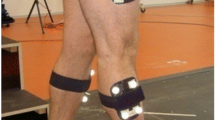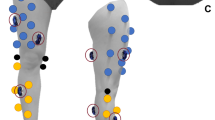Abstract
It has previously been shown that knee injuries with ACL ruptures may lead to decreased proprioception and that exercise in a normal population, uninjured individuals, may reduce the proprioceptive ability. How proprioception is affected by exercise in patients with ACL deficiency has, to our knowledge, not been studied before. Knee joint proprioception was estimated in 36 patients, 18 males and 18 females, with ACL deficiency by measuring thresholds for detection of slow passive motion before and after a short period of exercise on an ergometer bicycle. In addition, the results were compared with a control group of 24 individuals of the same age. We found trends of enhanced proprioception towards extension in the patient group after cycling, but not in the control group. Towards flexion, both groups showed poorer proprioception after cycling. When difference scores of proprioceptive change in each group were compared, a trend towards different reaction upon cycling between the groups was seen in measurement towards extension from 20° where the patients seemed to improve proprioception, which the controls did not. The results are not conclusive in this pilot study, but the possibility that ACL-deficient patients and controls may not react likewise to cycling, as regards their proprioceptive ability, is discussed.



Similar content being viewed by others
References
Assimakopoulos AP, Katonis PG, Agapitos MV, Exarchou EI (1992) The innervation of the human meniscus. Clin Orthop 232–236
Barrack RL, Skinner HB, Buckley SL (1989) Proprioception in the anterior cruciate deficient knee. Am J Sports Med 17:1–6
Barrack RL, Skinner HB, Cook SD (1984) Proprioception of the knee joint. Paradoxical effect of training. Am J Phys Med 63:175–181
Borg G (1990) Psychophysical scaling with applications in physical work and the perception of exertion. Scand J Work Environ Health 16:55–58
Bouët V, Gahery Y (2000) Muscular exercise improves knee position sense in humans. Neurosci Lett 289:143–146
Corrigan JP, Cashman WF, Brady MP (1992) Proprioception in the cruciate deficient knee. J Bone Joint Surg Br 74:247–250
Djupsjobacka M, Johansson H, Bergenheim M, Sjolander P (1995) Influences on the gamma-muscle-spindle system from contralateral muscle afferents stimulated by KCl and lactic acid. Neurosci Res 21:301–309
Djupsjobacka M, Johansson H, Bergenheim M, Wenngren BI (1995) Influences on the gamma-muscle spindle system from muscle afferents stimulated by increased intramuscular concentrations of bradykinin and 5-HT. Neurosci Res 22:325–333
Ericson M (1986) On the biomechanics of cycling. A study of joint and muscle load during exercise on the bicycle ergometer. Scand J Rehabil Med Suppl 16:1–43
Ericson MO, Nisell R, Arborelius UP, Ekholm J (1985) Muscular activity during ergometer cycling. Scand J Rehabil Med 17:53–61
Friden T, Roberts D, Movin T, Wredmark T (1998) Function after anterior cruciate ligament injuries. Influence of visual control and proprioception. Acta Orthop Scand 69:590–594
Friden T, Roberts D, Zatterstrom R, Lindstrand A, Moritz U (1996) Proprioception in the nearly extended knee. Measurements of position and movement in healthy individuals and in symptomatic anterior cruciate ligament injured patients. Knee Surg Sports Traumatol Arthrosc 4:217–224
Friden T, Roberts D, Zatterstrom R, Lindstrand A, Moritz U (1997) Proprioception after an acute knee ligament injury: a longitudinal study on 16 consecutive patients. J Orthop Res 15:637–644
Friden T, Roberts D, Zatterstrom R, Lindstrand A, Moritz U (1999) Proprioceptive defects after an anterior cruciate ligament rupture: the relation to associated anatomical lesions and subjective knee function. Knee Surg Sports Traumatol Arthrosc 7:226–231
Gordon JGC (1991) Modality coding in the somatic sensory system. In: Kandel ER, Schwartz JH, Jessel TM (eds) Principles of neural science, 3rd edn. Elsevier, New York, pp 564–581
Grigg P, Hoffman AH (1982) Properties of Ruffini afferents revealed by stress analysis of isolated sections of cat knee capsule. J Neurophysiol 47:41–54
Hutton RS, Nelson DL (1986) Stretch sensitivity of Golgi tendon organs in fatigued gastrocnemius muscle. Med Sci Sports Exerc 18:69–74
Jerosch J, Prymka M (1996) Knee joint proprioception in normal volunteers and patients with anterior cruciate ligament tears, taking special account of the effect of a knee bandage. Arch Orthop Trauma Surg 115:162–166
Johansson H, Sjolander P, Sojka P (1990) Activity in receptor afferents from the anterior cruciate ligament evokes reflex effects on fusimotor neurones. Neurosci Res 8:54–59
Johansson H, Sjolander P, Sojka P (1991) A sensory role for the cruciate ligaments. Clin Orthop 161–178
Johansson H, Sjolander P, Sojka P (1991) Receptors in the knee joint ligaments and their role in the biomechanics of the joint. Crit Rev Biomed Eng 18:341–368
Johansson H, Sjolander P, Sojka P (1991) Fusimotor reflex profiles of individual triceps surae primary muscle spindle afferents assessed with multi-afferent recording technique. J Physiol 85:6–19
Knuttgen HG, Saltin B (1972) Muscle metabolites and oxygen uptake in short-term submaximal exercise in man. J Appl Physiol 32:690–694
Krauspe R, Schmidt M, Schaible HG (1992) Sensory innervation of the anterior cruciate ligament. An electrophysiological study of the response properties of single identified mechanoreceptors in the cat. J Bone Joint Surg Am 74:390–397
Lattanzio PJ, Petrella RJ (1998) Knee proprioception: a review of mechanisms, measurements, and implications of muscular fatigue. Orthopedics 21:463–471
Lattanzio PJ, Petrella RJ, Sproule JR, Fowler PJ (1997) Effects of fatigue on knee proprioception. Clin J Sport Med 7:22–27
Ljubisavljevic M, Anastasijevic R (1996) Fusimotor system in muscle fatigue. J Peripher Nerv Syst 1:83–96
Ljubisavljevic M, Jovanovic K, Anastasijevic R (1992) Changes in discharge rate of fusimotor neurones provoked by fatiguing contractions of cat triceps surae muscles. J Physiol 445:499–513
Ljubisavljevic M, Jovanovic K, Anastasijevic R (1992) Changes in discharge rate of cat hamstring fusimotor neurones during fatiguing contractions of triceps surae muscles. Brain Res 579:246–252
Marks R, Quinney HA (1993) Effect of fatiguing maximal isokinetic quadriceps contractions on ability to estimate knee-position. Percept Mot Skills 77:1195–1202
Nawata K, Teshima R, Morio Y, Hagino H, Enokida M, Yamamoto K (1999) Anterior–posterior knee laxity increased by exercise. Quantitative evaluation of physiologic changes. Acta Orthop Scand 70:261–264
Noakes TD (2000) Physiological models to understand exercise fatigue and the adaptations that predict or enhance athletic performance. Scand J Med Sci Sports 10:123–145
Pedersen J, Ljubisavljevic M, Bergenheim M, Johansson H (1998) Alterations in information transmission in ensembles of primary muscle spindle afferents after muscle fatigue in heteronymous muscle. Neuroscience 84:953–959
Pedersen J, Lonn J, Hellstrom F, Djupsjobacka M, Johansson H (1999) Localized muscle fatigue decreases the acuity of the movement sense in the human shoulder. Med Sci Sports Exerc 31:1047–1052
Risberg MA, Beynnon BD, Peura GD, Uh BS (1999) Proprioception after anterior cruciate ligament reconstruction with and without bracing. Knee Surg Sports Traumatol Arthrosc 7:303–309
Roberts D, Ageberg E, Andersson G, Friden T (2003) Effects of short-term cycling on knee joint proprioception: comparison of proprioceptive ability before and after cycling on an ergometer bicycle. Am J Sports Med 31
Roberts D, Friden T, Stomberg A, Lindstrand A, Moritz U (2000) Bilateral proprioceptive defects in patients with a unilateral anterior cruciate ligament reconstruction: a comparison between patients and healthy individuals. J Orthop Res 18:565–571
Roberts D, Friden T, Zatterstrom R, Lindstrand A, Moritz U (1999) Proprioception in people with anterior cruciate ligament-deficient knees: comparison of symptomatic and asymptomatic patients. J Orthop Sports Phys Ther 29:587–594
Schultz RA, Miller DC, Kerr CS, Micheli L (1984) Mechanoreceptors in human cruciate ligaments. A histological study. J Bone Joint Surg Am 66:1072–1076
Schutte MJ, Dabezies EJ, Zimny ML, Happel LT (1987) Neural anatomy of the human anterior cruciate ligament. J Bone Joint Surg Am 69:243–247
Sjolander P (1989) A sensory role for the cruciate ligaments. Dissertation, University of Umeå, Sweden
Sjolander P, Johansson H, Sojka P, Rehnholm A (1989) Sensory nerve endings in the cat cruciate ligaments: a morphological investigation. Neurosci Lett 102:33–38
Skinner H, Wyatt MP, Stone ML, Hodgdon JA, Barrack RL (1986) Exercise-related knee joint laxity. Am J Sports Med 14:30–34
Skinner HB, Wyatt MP, Hodgdon JA, Conard DW, Barrack RL (1986) Effect of fatigue on joint position sense of the knee. J Orthop Res 4:112–118
Sojka P, Sjolander P, Johansson H, Djupsjobacka M (1991) Influence from stretch-sensitive receptors in the collateral ligaments of the knee joint on the gamma-muscle-spindle systems of flexor and extensor muscles. Neurosci Res 11:55–62
Steiner ME, Grana WA, Chillag K, Schelberg-Karnes E (1986) The effect of exercise on anterior–posterior knee laxity. Am J Sports Med 14:24–29
Stoller DW, Markolf KL, Zager SA, Shoemaker SC (1983) The effects of exercise, ice, and ultrasonography on torsional laxity of the knee. Clin Orthop 174:172–180
Tegner Y, Lysholm J (1985) Rating systems in the evaluation of knee ligament injuries. Clin Orthop 198:43–49
Weisman G, Pope MH, Johnson RJ (1980) Cyclic loading in knee ligament injuries. Am J Sports Med 8:24–30
Zätterström R (1999) The injured anterior cruciate ligament and neuromuscular rehabilitation. Thesis, University of Lund, Sweden
Acknowledgements
The authors thank M. Christensson, Department of Medical Technology, for his construction of the apparatus used, all the subjects who volunteered to take part in the study, and P.-E. Isberg for statistical advice. Financial support from Medicinska forskningsrådet, project no. 09509, Stiftelsen för Bistånd åt Vanföra i Skåne, Syskonen Persson’s Donation fund, Svenska Sällskapet för Medicinsk Forskning, Thyr och Thure Stenemark’s Fund, Centrum för Idrottsforskning, the Swedish Society of Medicine, the National Board of Health and Welfare and the Faculty of Medicine, Lund University is gratefully acknowledged.
Author information
Authors and Affiliations
Corresponding author
Rights and permissions
About this article
Cite this article
Roberts, D., Ageberg, E., Andersson, G. et al. Effects of short-term cycling on knee joint proprioception in ACL-deficient patients. Knee Surg Sports Traumatol Arthrosc 12, 357–363 (2004). https://doi.org/10.1007/s00167-003-0468-2
Received:
Accepted:
Published:
Issue Date:
DOI: https://doi.org/10.1007/s00167-003-0468-2




